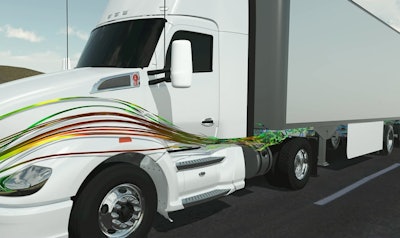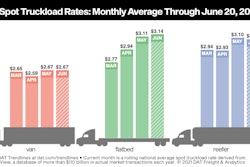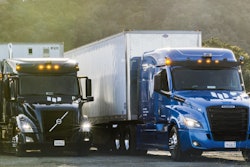
Everything is connected.
As a technologist,or futurist or engineer or whatever my job is today after nearly 40 years in industry, it never ceases to amaze me how everything seems to be interconnected. I have done research and writing about battery electric vehicles, fuel cell vehicles and other hybrid electric vehicles for some time, but my roots are firmly in the diesel world.
All powertrain alternatives care about efficiency.
Put simply, dollars-per-mile ($/mi) is a key performance indicator (KPI) that doesn’t care if your current engine runs on diesel, CNG, RNG, electricity, hydrogen, propane, or any of a hundred other permutations of energy. It’s a business metric that everyone wants to improve no matter what drivetrain the vehicle is running.
If your competitors can move freight cheaper today than you can, they make more money and have more opportunity to attract customers. This is Business 101. Long-term, fleets can plan technology transitions, but also have to operate in the here and now with the trucks they have today.
Don’t get me wrong. I am a strong advocate of improving the environment, improving inclusion, improving social justice, and all that those things entail. But those factors also can be put in perspective of total cost of ownership and ultimately measured in dollars.
The true cost of operating a truck has a lot of soft costs that need to be captured but haven’t been because in the past they were thought to be too difficult to capture. The costs are real and they are significant, but we haven’t been able to properly put them on a balance sheet. That is changing. Environmental accounting and social accounting are now starting to enter the calculations. Turns out that using less energy per mile generally also tends to improve the environment and improves the societal impacts of trucking.
Which brings me back to the common ground in trucking. More efficient trucking is a shared goal for any powertrain. I’ve spent a career helping move the bar on aerodynamics. My first truck project in 1981 involved making a cab-over quieter. Turns out wind noise is a big issue — welcome to aerodynamics. Over time, I worked on the iconic long-and-tall Peterbilt 379 model and helped morph the product line into a family of new aerodynamic trucks including the Model 385, Model 387, Model 386, Model 579, and the Peterbilt SuperTruck.
Writing for NACFE, I’ve co-authored reports on Tractor Aerodynamics, Trailer Aerodynamics, and Determining Efficiency. My 2016 SAE Buckendale Fuel and Freight Efficiency - Past, Present and Future Perspectives is still very relevant. I’ve contributed to the SAE groups working on standards for measuring fuel economy, and I’ve written SAE papers and NACFE papers on platooning — that act of using drafting to improve the fuel economy of a pair or more of vehicles. I’ve also spent a good deal of time on the road observing real-world trucks in operation in the U.S., Canada, Mexico, Europe and Australia.
Cooperative Adaptive Cruise Control (CACC) is one of the terms describing technology behind platooning. It’s a proper rebranding since the term “platooning” seems to evoke disagreement among major OEMs as a viable technology, where CACC seems to be universally acceptable. MAN has coined platooning as an electronic drawbar. Semantics are for marketing people. I’m an engineer. It all comes down to aerodynamic drafting and safety.
If you look into guidance on “safe following distances” you find that it largely is open to interpretation. One guide indicates you need one second of separation for every 10 feet of vehicle length, plus one additional second if traveling over 40 mph. That translates into eight seconds of separation between you and the vehicle in front. At 70 mph, that’s about 800 feet of separation, or about 11 semi-truck lengths.
Another source recommends four seconds, so about 400 feet, or about six truck lengths. Drive around a bit and you’ll see plenty of situations where this is not happening in real-world traffic. Ultimately all the drivers in traffic – trucks and autos alike – are responsible for safely navigating the highways. If no accident occurs, they succeeded. If an accident does occur, then causation is investigated.
My point is that drafting is going on every day all around you in moving traffic. I wrote about this back in 2016 in Two-Truck Platooning and in 2015 in an SAE report 2015-01-2897 Aerodynamic Comparison of Tractor-Trailer Platooning and A-Train Configuration where it was clear that a vehicle in front of another vehicle, even at multiple vehicle lengths, can and does positively impact the aerodynamics of the following vehicle.
More recently the National Research Council (NRC) has attempted to quantify that affect through wind tunnel and road testing documented in SAE Report 2018-01-1181 Influences on Energy Savings of Heavy Trucks Using Cooperative Adaptive Cruise Control. This report documents extensive joint testing with the NRC Canada, National Renewable Energy Laboratory, University of California-Berkeley, FPInnovations, and the Volvo Group.
They were able to quantify in controlled repeatable testing that a truck following an SUV at 65 mph sees a fuel economy improvement of anywhere from 1.5% to 2.6% when the gap between them is between ~140 feet to ~290 feet. An average car is about 15 feet long, so that’s between nine to 19 car lengths that the car in front is creating a benefit for the truck behind. If the vehicle in front is a truck, the benefit is even better – from 4% to 6% at those same gaps. As the gaps shorten, the savings from drafting generally improve.
Real-world traffic sees gaps shorter than this regularly, so drafting is occurring all the time vehicles are in moving traffic irrespective of whether or not they intentionally are platooning. And that applies whether or not the vehicles are diesel, battery electric, gasoline, or any other type of powertrain. I’ve estimated from data collected in road experiments that vehicles are in moving traffic conditions 40% to 50% of their time on Interstates.
What CACC, electronic draw bar, or just plain platooning bring to the table are added layers of safety through automating decision making for vehicles and taking human reaction times out of braking and maneuvering events. This safety enhancement is also directly relevant to any powertrain choice. It’s not all about fuel economy, but rather reducing accident rates. This also goes to the balance sheet as a win.
I would be remiss if I did not also mention that there are additional intelligent ways to improve freight efficiency. As ADAS systems become more prevalent in autos and trucks, the opportunity is there to expand use of long combination vehicles (LCV). In presenting my SAE paper in 2015, I stated that if platooning is good, LCVs are better. This is true across the range of factors from safety, operating costs, capital costs, maintenance costs, driver pay, driver shortage and road wear. Canada and Australia can support this where both have extensive operational histories with these vehicles, as do some U.S. states.
The NRC tests included testing a two-truck platoon, each tractor pulling a 53-foot trailer versus a single tractor pulling two 53-foot trailers. They found that the maximum gain measured in fuel economy for moving the two trailers from platooning was ~7% while the net gain from the LCV was 28%. We should use all the tools available in our toolbox to improve efficiency. Expansion of LCV use is one tool that is worth a focus, regardless of powertrain choice.
In the end, freight efficiency is about moving more freight with less energy and less cost. Improving aerodynamics are relevant to all powertrain choices, and there are still significant savings possible from low hanging fruit.
Rick Mihelic is NACFE’s Director of Emerging Technologies. He has authored for NACFE four Guidance Reports on electric and alternative fuel medium- and heavy-duty trucks and several Confidence Reports on Determining Efficiency, Tractor and Trailer Aerodynamics, Two Truck Platooning, and authored special studies on Regional Haul, Defining Production and Intentional Pairing of tractor trailers.











